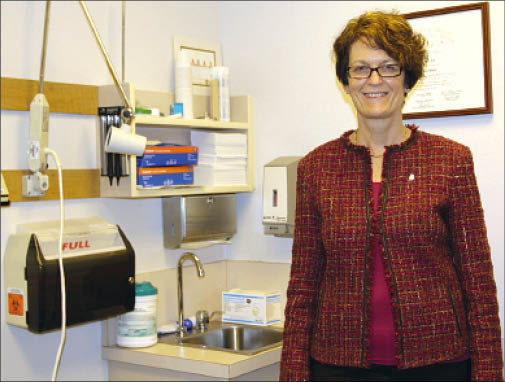
Home » The vitamin D debate
The vitamin D debate
More providers monitor nutrient levels in patients; some view supplements skeptically

March 24, 2011
Vitamin D can help boost bone health. While it's thought to have other health benefits, how much or how little opens up some debate among Inland Northwest health providers.
Within the past two years, doctors here have stepped up their screening for vitamin D deficiency, medical professionals say. Part of that trend, they say, is due to the reality that people aren't exposed to as much sunlight at northern latitudes, and ultraviolet rays from direct sunlight are considered to be a good source of vitamin D. In addition, doctors attribute the screening trend to reported links between the deficiency of the nutrient and many health concerns.
At the same time, some doctors recommend caution toward vitamin D supplements.
Dr. Carol Wysham, an endocrinologist at Rockwood Clinic's Diabetes and Endocrinology Center, says that low levels of vitamin D have long been linked to concerns about osteoporosis, a bone disease prevalent in post-menopausal women. In more recent years, she adds that medical professionals have considered the possible correlation of vitamin D deficiency to health concerns such as multiple sclerosis and cardiovascular disease.
"We as doctors are recently more aware," says Wysham about vitamin D screening. She sees patients for diabetes, thyroid conditions, and osteoporosis. Because of her work with osteoporosis, she sees many women.
"I'd say 90 percent of people I test are low in vitamin D levels. Granted, I tend to see middle age to older patients," she says.
She usually tells patients to take a vitamin D supplement of between 1,000 to 2,000 individual units (IU) per day. Wysham cautions, however, that people also consider the vitamin D they get from other sources, such as a daily vitamin and diet. Any amount over 4,000 IU "goes beyond what most people should take," and too much vitamin D potentially can have adverse effects, such as contributing to kidney stones, she says.
Liver and oily fish, such as salmon, are the main food sources of vitamin D, while milk and a few other foods, such as cereal, have vitamin D added to them, Wysham says. "It's unlikely that people will get enough vitamin D from food, so most people are going to require a vitamin D supplement," she adds. An exception might be teenagers who have high dairy intake.
Spokane family physician Dr. William Sayres Jr. says upfront he is a vitamin D skeptic. He agrees more doctors here are requesting general screening for vitamin D levels in their patients, but he questions the need to supplement vitamin D levels in patients who don't have osteoporosis.
"There is tremendous controversy in the medical community," he says, about the connection between vitamin D deficiency and health. He points to two scientifically proven benefits of sufficient levels— its link to preventing rickets, which is the softening of the bones in children, and its role in bone health for older people.
"That's the only science of vitamin D supplementation," he says.
Sayres says he knows a number of medical professionals here who think vitamin D is crucial.
"I've got partners who completely disagree with me, and they think vitamin D is key," he says. "They screen all their patients, and they believe in vitamin D supplements."
He adds that discussions about health benefits linked to multiple sclerosis and other health conditions aren't robust enough to make general recommendations. He points to a recent Institute of Medicine report that suggests vitamin D probably runs lower in the U.S. population than it should.
However, he says, the institute doesn't recommend general screening, only that most people take a supplement of 600 IU of vitamin D daily up to age 70, and then 800 IU after that for those not physically active.
Sayres says, "People don't even agree on what vitamin D deficiency is," and he adds that labs assigned to do blood tests may use different thresholds to measure vitamin D deficiency.
The Institute of Medicine report says, " ... national surveys show that average blood levels of vitamin D are above the 20 nanograms per milliliter that the IOM committee found to be the level that is needed for good bone health for practically all individuals."
Sayres says some physicians think anything above 20 nanograms per milliliter is considered normal, while others say 30 nanograms is what it should be, and that anything less than 30 is deficient.
"Vitamin D is associated with a lot of things, but we don't have the information to say that just because it's associated with these things, we need to supplement," he says. "We don't know if giving people megadoses of vitamin D will cause any problems because we've never done it before."
Another health professional here, pharmacist Edie Ward, supports vitamin D supplements. She works mostly with women and is a certified menopause practitioner at Riverpoint Pharmacy, at 528 E. Spokane Falls Blvd. Ward received her credentials from the North American Menopause Society, which recommends vitamin D supplements for bone and breast health.
"Even in the summer, I still repeatedly see low vitamin D levels in people who are otherwise tan," says Ward. "With the intensity of the sun we get here and the latitude, it isn't enough. Also, people use sunscreen and that blocks 97 to 100 percent of the vitamin D production."
Ward says the pharmacy several years ago started asking to review patients' lab panels, or group of tests, to understand hormone levels and vitamin D levels for mostly menopausal and post-menopausal women who seek hormone replacement therapy.
"For every new patient I get, more than 90 percent have low vitamin D levels, and that's regardless of the time of year," Ward says. "I probably have four new patients a day."
Ward recommends vitamin D drops, versus pills, because the drops are compounded in oil, which seems to improve absorption, she says. She adds that vitamin D naturally is a fat soluble substance.
"I do see better levels in women who use the drops rather than the pills," she says.
Ward says vitamin D supplements can help in the treatment of seasonal affective disorder, osteoporosis, autoimmune diseases, multiple sclerosis, and rheumatoid arthritis, among other conditions.
Wysham also says medical professionals are considering vitamin D deficiency's correlation to conditions such as diabetes and autoimmune diseases. "There is the potential that breast cancer risk may be related." However, she adds, "the only scientific proof we have is that with sufficient vitamin D levels, there is a decreased risk of osteoporosis and bone fractures."
An article in the Journal of The American Board of Family Medicine suggests that people expose arms and legs to sunlight five to 30 minutes a day to prevent deficiency.
However, other factors such as cloud cover and the angle of the sun often don't allow for the right conditions, says Wysham. "You'd have to live in the very southern tier of the United States."
Latest News




_web.jpg?1712818920)